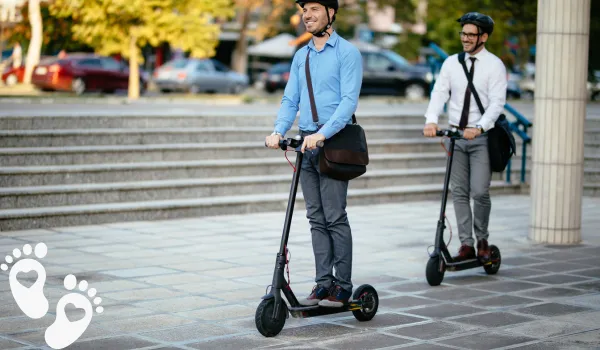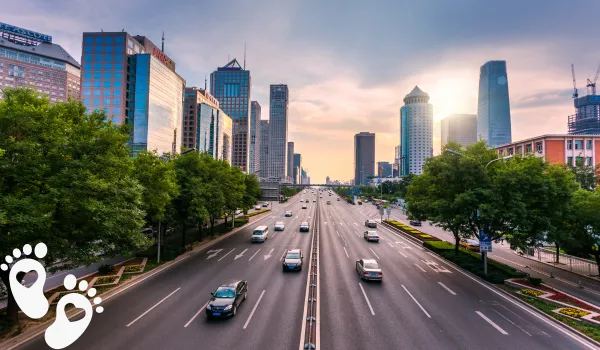The Best Eco-Friendly Transportation Methods To Reduce Your Carbon Footprint
Unlock the secrets to guilt-free travel with our ultimate guide to the best eco-friendly transportation methods that will help you shrink your carbon footprint without sacrificing adventure.
Seeking to shrink your carbon footprint and adopt a greener lifestyle? The key could lie in switching to eco-friendly transportation methods. In this blog, we delve into the best green transportation options that are cost-effective, enjoyable, and beneficial for the environment.
These choices, ranging from biking and walking to electric vehicles and public transport, not only address long distances but also substantially reduce your environmental impact, adding a positive twist to your daily commutes while nurturing our planet’s health.
- Cycling and walking are great eco, friendly transportation options that can significantly reduce greenhouse gas emissions and traffic congestion while providing health benefits.
- Public transport, such as buses and trains, offers a sustainable mode of transportation with environmental and financial benefits.
- Electric vehicles (EVs) provide zero-emission capabilities with the added bonus of lower fuel and maintenance costs.
- Carpooling and alternative modes of transport like electric longboards, bikes, and scooters are also great ways to reduce your carbon footprint on short-distance commutes.
Types Of Eco-Friendly Transportation
Cycling and walking, public transport, electric vehicles, carpooling, and alternative modes of transport such as longboards, bikes, and scooters are all great eco-friendly transportation options.
Cycling And Walking

Embracing cycling and walking as sustainable transportation methods is a fantastic way for individuals to reduce their carbon footprint while enjoying numerous health benefits.
Get Your Hand on Your Eco-Friendly Living Starter Guide!
Swapping out cars for bicycles or taking a stroll instead of driving helps decrease greenhouse gas emissions, alleviates traffic congestion, and lowers the demand for oil.
For instance, consider the bustling city of Copenhagen, where over 60% of residents cycle daily for commuting purposes, making it one of the greenest cities in the world.
This widespread adoption of cycling has led to improved air quality, less pollution, and an increased number of green spaces throughout the city. Additionally, incorporating active transportation modes such as biking or walking into your everyday routine offers significant health advantages by promoting physical activity and combating sedentary lifestyles.
Public Transport

Public transport is an increasingly popular mode of eco-friendly transportation, offering numerous benefits for both the environment and its users. By choosing buses, trains, or trams over single-occupancy vehicles, individuals can significantly reduce their carbon footprint while conserving energy.
Many cities worldwide have acknowledged the positive impact public transportation systems provide on our environment and are investing heavily in expanding these services.
For instance, electric buses are becoming more prevalent as they produce zero emissions during operation. Furthermore, rail travel has also gained attention due to its high efficiency and potential use of renewable energy sources such as wind or solar power.
In addition to these environmentally friendly aspects, public transport offers financial savings through reduced fuel and maintenance costs associated with personal vehicle ownership.
Electric Vehicles
Electric vehicles (EVs) have gained popularity as one of the top eco-friendly transportation methods in recent years. With their zero-emission capabilities, EVs offer a significant reduction in air pollution and greenhouse gas emissions compared to traditional internal combustion engine cars.
Not only do EVs provide environmental benefits but also financial savings on fuel and maintenance costs. As technology advances, electric cars are becoming more practical with longer battery ranges and increased availability of charging stations.
Popular examples include Tesla’s lineup of sleek all-electric models and affordable options such as the Nissan Leaf or Chevrolet Bolt.
Carpooling
Carpooling is one of the most eco-friendly transportation options available for reducing your carbon footprint. It involves sharing a ride with one or more individuals to reach the same destination, which can reduce greenhouse gas emissions and traffic congestion on the road.
Electric Longboards, Bikes, & Scooters

Electric longboards, bikes, and scooters are taking the world by storm as environmentally friendly options for transportation. Electric longboards offer a sleek and eco-friendly way to travel short distances or commute to work.
They emit no toxic fumes and help reduce air pollution while providing an efficient means of getting around town. Electric bikes have become increasingly popular in urban areas due to their ability to revolutionize the way we think about transportation.
While electric scooters may seem like a good option at first glance, they are not currently considered a truly eco-friendly mode of transportation due to manufacturing processes that contribute significant greenhouse gas emissions.
Advantages Of Eco-Friendly Transportation
Eco-friendly transportation offers numerous benefits, including reduced pollution, improved air quality, and saving money on fuel and maintenance costs.
Reduced Pollution
Choosing eco-friendly transportation options such as public transit, biking, and walking can significantly reduce pollution and improve air quality. In fact, taking public transportation instead of driving a personal vehicle can reduce CO2 emissions by up to 45%.
This reduction in pollutants has a direct impact on the environment and our health. By reducing greenhouse gas emissions from vehicles, we also help decrease the risk of global climate change.
Not only does sustainable transportation benefit the environment, but it can also save individuals money on fuel and maintenance costs while reducing traffic congestion.
Improved Air Quality

Using environmentally friendly ways of transportation can significantly improve air quality. Forms of sustainable transport, such as cycling, walking, and public transit, emit fewer pollutants compared to traditional modes like cars and motorcycles.
For instance, driving less or choosing fuel-efficient vehicles can help reduce greenhouse gas emissions that contribute to poor air quality.
Switching to public transit is a highly effective way of reducing carbon footprint while also improving air quality in crowded urban centers. Public transportation generates fewer emissions per person than single-occupancy vehicles on the road and has the potential to eliminate traffic congestion altogether.
Health Benefits
Using eco-friendly transportation methods doesn’t just benefit the environment. It also has positive effects on your own health. For instance, biking or walking to work can increase physical activity levels and reduce the risk of chronic diseases such as heart disease and obesity.
Moreover, driving alone in a car releases harmful pollutants into the air, which can negatively impact respiratory health.
Finally, reducing traffic congestion through carpooling or alternative modes of transport not only saves time but also reduces stress levels commonly associated with commuting by car.
By prioritizing eco-friendly transportation methods over traditional ones, like driving alone in cars every day, we make conscious choices that have long-lasting benefits for both ourselves and future generations.
Saving Money On Fuel And Maintenance Costs
One of the biggest benefits of using eco-friendly transportation methods is the significant cost savings on fuel and maintenance costs. For instance, choosing to walk or bike for short trips can eliminate the need for a car altogether, saving individuals thousands of dollars in gas, oil changes, and repairs each year.
Moreover, electric vehicles are more energy-efficient than traditional gasoline-powered cars and require less frequent servicing due to their fewer moving parts. These are all great examples of green transportation with major upsides.
Research has shown that the average American spends nearly $3K annually on gas alone, with additional maintenance costs. Choosing alternative forms of transportation not only saves money but also helps reduce air pollution caused by vehicle emissions which can harm our health in many ways.
Reduced Traffic Congestion

One of the biggest advantages of eco-friendly transportation methods is the reduction in traffic congestion. By reducing the number of vehicles on the road, we can ease traffic jams and improve travel times for everyone.
Taking public transportation like buses or trains not only cuts down on traffic but also reduces carbon dioxide emissions by up to 45%, compared to driving alone. Carpooling and ridesharing are other great ways to reduce congestion while saving money on fuel costs.
Plus, bicycling and walking help lessen our dependence on cars altogether, leading to fewer vehicles clogging up our roads during rush hour.
Plan and Allocate Extra Time
When adopting eco-friendly transportation methods, planning and allocating extra time is key. This approach reduces stress and ensures you reach your destination without rushing. For instance, when opting to walk or bike to work instead of driving, providing yourself ample time helps avoid being late.
This also allows you to explore alternative transportation options like public transit or carpooling, which can reduce traffic congestion, lower greenhouse gas emissions, and save money on fuel and parking costs.
Investment in Essential Equipment
Investing in necessary equipment can make eco-friendly transportation a seamless part of your daily routine. This includes:
- Bike: An affordable and healthy option, biking helps to reduce your carbon footprint and eliminates concerns about fuel costs and air pollution.
- Helmet: Prioritizing safety is crucial, and investing in a quality helmet can protect against head injuries.
- Electric Car: Although initially expensive, electric cars save money on fuel costs in the long run and drastically cut greenhouse gas emissions. Moreover, tax credits and rebates often make them a more accessible choice.
Choose a Convenient Route
Selecting a convenient route can significantly increase your commitment to eco-friendly transportation. Opt for shorter routes or ones with fewer hills if biking or walking, and if using public transportation, pick routes with easily accessible bus or train stops. Convenient routing not only saves time and effort but also contributes to reducing traffic congestion, air pollution, and fuel consumption.
Encourage Others

Encouraging others to join in eco-friendly transportation efforts can create a large impact on the environment. By promoting benefits such as reduced air pollution, improved health, and cost savings on maintenance and fuel, you can motivate friends, family, and coworkers to adopt sustainable transport options.
Sharing personal experiences and emphasizing the benefits of public transportation in reducing congestion and enhancing community accessibility can inspire others to make similar choices.
Conclusion
In conclusion, making small changes to the way we get around can have a big impact on our environment. By choosing eco friendly transportation methods, such as cycling, walking, public transit, electric vehicles, carpooling, and alternative modes of transport like electric longboards and scooters, we can reduce our carbon footprints and help create a healthier planet.
In addition to reducing pollution and improving air quality, using sustainable transportation options also helps us save money on fuel while promoting physical fitness.
FAQs:
What Are The Benefits Of Using Eco-Friendly Means Of Transportation?
By using eco-friendly transportation methods such as biking, walking, electric cars or public transit, you can help to reduce your carbon footprint and minimize your impact on the environment while promoting a healthier lifestyle. Additionally, it may save you money on fuel costs in the long run.
How Can I Incorporate More Eco-Friendly Transportation Into My Daily Routine?
You can begin incorporating more eco-friendly modes of transportation into your routine by planning ahead for trips and considering whether walking, biking, or taking public transport might be a better option than driving yourself.
Are There Any Government Incentives Available To Encourage People To Use Sustainable Transport?
Yes! Many governments offer initiatives like tax credits, rebates \u0026amp; subsidies for those switching to environmentally friendly alternatives in order to incentivize individuals \u0026amp; companies alike, ensuring environmental consciousness becomes an integral part of modern lifestyles.
How Does Air Travel Compare With Other Forms When It Comes To Carbon Emissions?
Air travel is generally considered one of the most carbon-intensive modes of transportation due to its heavy reliance on fossil fuels but new flight technologies, such as biofuels or hybrid engines, are being developed, which could help contribute towards slowing down climate change whilst still allowing convenient global travels without sacrificing convenience.
References:
- https://www.c2es.org/content/reducing-your-transportation-footprint/
- https://www.sustrans.org.uk/our-blog/get-active/2020/in-your-community/how-does-walking-and-cycling-help-to-protect-the-environment
- https://www.epa.gov/greenvehicles/electric-vehicle-myths
- https://transportation.ucla.edu/blog/5-environmental-benefits-sustainable-transportation






